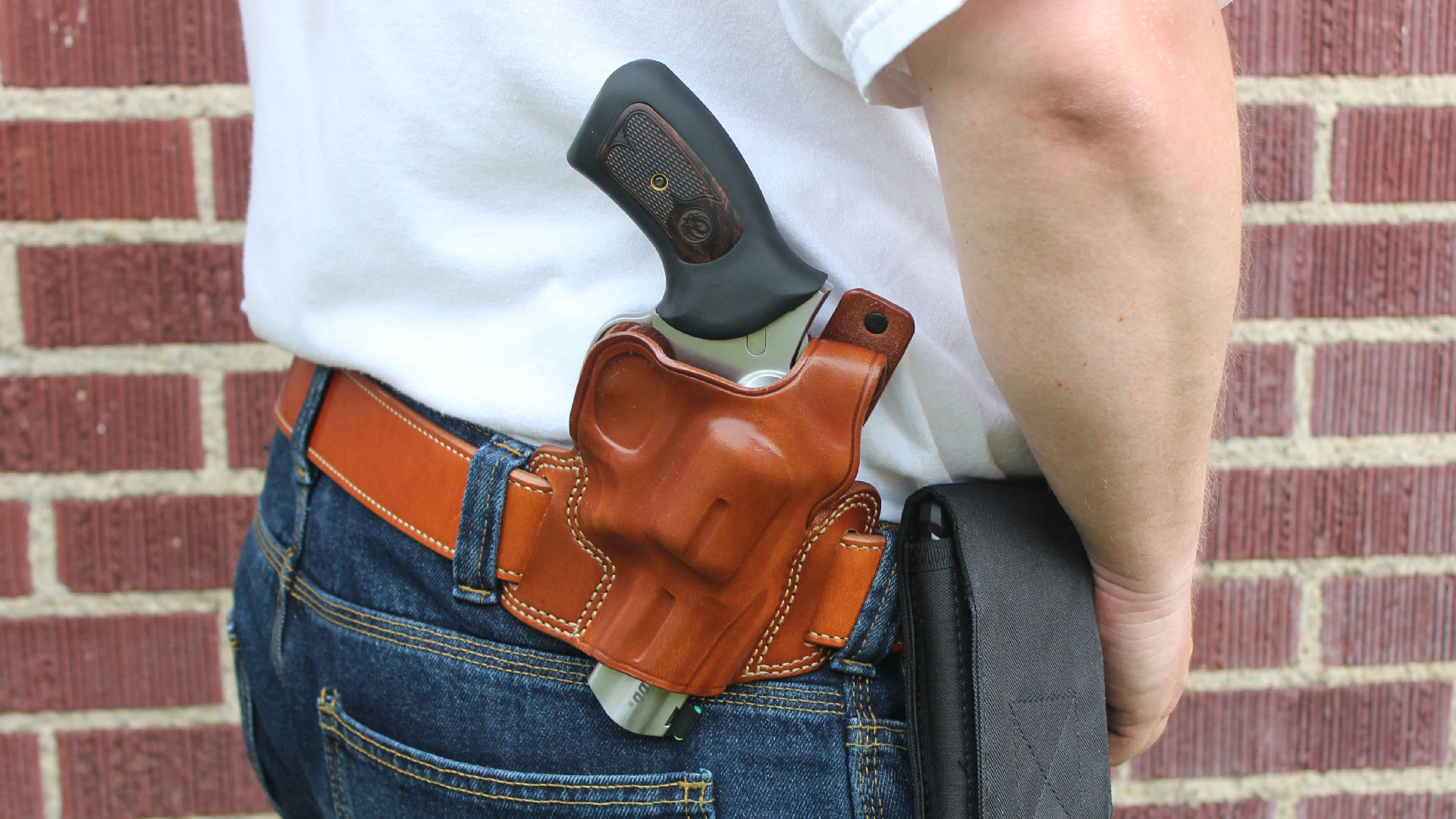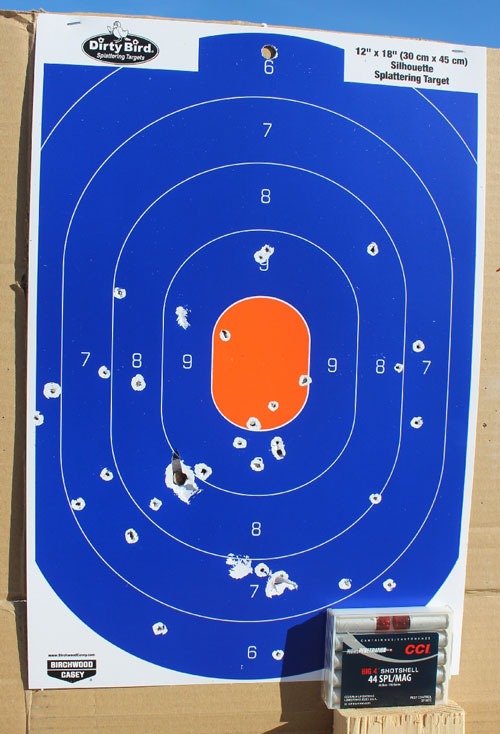
Over the last few decades, modern semi-automatic platforms, including AR-pattern rifles and polymer-framed pistols, have been steadily making their way from tactical and target-shooting related endeavors into the great outdoors. I'm not going to spend time making disparaging remarks about using semi-automatics as trail guns. They certainly have their place and I’m a dyed-in-the-wool fan of 10mm Auto pistols. So, don't be surprised to see my continued support for them in the future.
However, semi-automatics have been a mainstay of handgun shooting for long enough now that it's not uncommon to bump into gun owners who have yet to handle or fire a revolver of any size, let alone purchase one. In fact, you'll hear folks online diligently repeating rumors that started somewhere in the 1980s—namely that the revolver's day has passed.
As a handgun enthusiast who owned and shot big-bore, double-action revolvers years before even considering the purchase of a semi-automatic pistol, I have a different perspective on the subject. The conditions in which handguns play a defensive role in urban settings are rarely the same as those encountered on mountain trails or in the deep woods. With this in mind, I would like to take a few minutes to engage in a general discussion of the virtues of wheel guns for use on the trail.
Just a quick note before we begin. For the general comparisons made in this conversation, I'm going to stick with the more mainstream, regular-sized pistols and revolvers chambered in the more typical big-bore calibers. Let's save the bravado of the oversized Magnum Research Desert Eagles, Smith & Wesson X-Frames, bolt-action rifle caliber pistols and similar models for another day.
The Question of Ammunition Capacity
Over the last three decades we've seen two philosophies shape the way that self-defense instructors train their students to protect themselves with handguns in urban settings. This in turn has strongly influenced how folks prioritize their firearms' ammunition capacity. Since these tactics play a role in defensive planning, in or out of the city, it's useful to take a closer look at both of them here.
When I started taking classes in the mid to late 1990s, there was still an emphasis on what can be called ‘focused first shots.’ The idea being that the self defender was most likely to be faced with an individual threat—just one person with the means, motive and opportunity to kill them or to inflict grievous bodily harm.

Therefore, of all the shots that might have to be fired by the self defender, the first one would be the most important. It would need to be potent and properly placed so as to stop the threat immediately with possible follow-up shots fired if needed. Even though the transition from double-action revolvers to semi-automatics for law enforcement personnel was well under way by that time, there were still those who continued to prioritize handgun power over ammunition capacity. As a result, bigger, hard-hitting rounds that generated more recoil from handguns that held between 6- to 8-rounds of ammunition were preferable to those that held 10 to 18-rounds of a less powerful caliber. The key was to learn to manage the recoil so that the first hard-hitting round would be properly placed.
Fast forward to our current decade and the urban defensive philosophy has shifted. Rather than honing in on the importance of the first shot, instructors are now focusing on teaching their students how to engage multiple threats. It's not that the first shot fired is now less important per se, but that self defenders are now more likely to be confronted by two or more assailants working in teams. With this in mind, recoil management and ammunition capacity have taken precedence over performance power levels. This is why we see folks choosing to carry compact 9 mm pistols with ported barrels and 15-round magazines for their strolls around town. It's a sensible solution for this type of environment.

That being said, it's fair to say that the old-school handgun design philosophy of increased power levels rather than greater ammunition capacities still holds water in the great outdoors. To put it simply, black bears and larger-sized dangerous game animals are built differently than humans. Therefore, a people-sized defensive tool is not the optimal choice when faced with a bear-sized problem. This is where big-bore revolvers have a distinct advantage over typical semi-automatic pistols.
Performance Potential
No matter how you slice it, single-action and double-action revolvers can be significantly more powerful than semi-automatics while still remaining relatively comfortable to carry. In some regions of the country, trail trippers don't need handguns capable of hammer-of-the-gods power levels. If the largest potential threats are coyote, wild dog or feral hog sized, then a pistol chambered in 10mm, .45 ACP or even properly loaded 9 mm could do the trick. We recently posted a piece discussing how popular 9 mm pistols can, and can't, be put to work when trading the concrete jungle for wilderness terrain. Rather than reiterate that particular performance discussion here, I would invite you to follow the link.

But when we get into bear country, handgun performance needs change significantly. The venerable .357 Magnum revolver, loaded with full-power cartridges topped with bullets designed for deep penetration, is commonly considered the adequate minimum for bear medicine these days. By comparison, the 10mm Auto is the top of the duty-size pistol food chain with performance potential that can comfortably compete with, and even surpass, .357 Mag. by a respectable margin.

But once we move up to .44 Magnum (apologies to the .41 Rem. Mag. fans), the .357 Mag. and 10 mm Auto are clearly out classed. And the .44 Mag. in turn is less powerful than other standard revolver frame compatible cartridges including the .480 Ruger, .454 Casull and .475 Linebaugh, to name a few. Rather than belabor this point, let’s agree that revolvers have the edge when it comes to bullet energy potential.
Mixed Munitions & Reliability
As most folks know, semi-automatic pistols rely on the pressures generated by firing a cartridge to cycle the slide so as to eject the spent cartridge case and to chamber a fresh round from the magazine. If the pressure levels are too low or too high, the pistol can be jammed up by a failure to feed, or to eject and so on. Bullet shape can also be an issue depending on the age or make of the pistol in question. This means the ammunition selected for a pistol needs to operate within an optimal pressure range and have a compatible bullet shape to keep the action cycling smoothly.
Revolvers, on the other hand, do not suffer from the 'ammunition sensitivity' that can be an issue with some pistols. Revolver actions are mechanically operated. As the hammer is cocked, either by thumbing back the hammer or pulling the trigger, the cylinder is rotated so that the next chamber is aligned with the barrel. After the cartridge is fired, the chamber containing the spent cartridge remains in place until the hammer is cocked again to rotate the cylinder once more.

Because revolvers do not rely on the ammunition to operate the action, they can be fired with a broad range of ammunition power levels and bullet types with no negative effect on reliability. Bullets’ group sizes and point of impact will change from load to load, but the revolver will keep on chambering, firing and manually ejecting even if each chamber holds a different load. And if a round happens to have a bad primer, there's no need to tap-and-rack to get the revolver back in action. Just pull the trigger again to move on to the next loaded chamber.
This operational characteristic of revolvers is particularly handy in two cases. The first is when it's necessary to work with 'whatchagot' or what-you-can-find ammunition. Revolvers tend to be roach guns, meaning, they can keep on working even if the ammunition on hand is less powerful, more powerful or topped with different bullets than you usually prefer.

This ability to mix munitions is also helpful in areas where venomous snakes and dangerous game are both a concern. Semi-automatics can be loaded with snake shot rounds, like CCI's Pest Control shells. These rounds are topped with capsules of fine birdshot which turn pistols into little short-range shotguns ideal for dispatching snakes, rats and similarly sized vermin. But these cartridges also temporarily convert pistols into single-shot handguns because they lack the pressure levels required to reliably cycle the slide.
Because revolvers cycle regardless of cartridge pressure levels, a chamber or two can be loaded with snake shot while the remaining chambers are stoked with dangerous game stoppers. Earlier this year I conducted an evaluation of a new series of revolver snake-shot loads from DoubleTap Ammunition. You can see the results here.
Shooter Induced Malfunctions (aka Limp-Wristing)
This one was saved for last because it is something that often goes overlooked these days when folks who are new to big-bore handguns are considering their options. It's also the primary point that inspired this write-up in the first place.
This previous post addresses the recent trend we've seen among wilderness enthusiasts of adopting polymer-framed 10mm Auto handguns like the Glock G20, Smith & Wesson M&P M2.0 and the Springfield Armory XD-M Elite for use as trail guns. Among the reasons for doing so is that the learning curve can be shorter when switching from a 9mm pistol to a 10mm pistol since the controls, features and operations are nearly the same even if the levels of felt recoil are noticeably different.

But there's more to managing recoil with semi-automatics than just the shooter's comfort levels. As touched on earlier, pistols rely on cartridge pressure to operate. But that's only half of the formula. In order for the slide to cycle, the pistol's frame has to be held firmly in place as the slide moves all the way back and then forward into battery again. If the person shooting does not have a firm enough hold for the given pistol and caliber being fired, the slide will not cycle properly and jams will occur much like those caused by low-pressure ammunition. This is a user-induced malfunction more commonly known as 'limp-wristing' the pistol.

Technically speaking, any semi-automatic pistol can be limp wristed. But for those who have less experience handling hard-kicking pistols like the 10mm, even when using well made models properly lubricated and loaded with quality ammunition, they can be jammed by an improper or loose grip. There's also the very real possibility that the shooting conditions may not be ideal. There's no time to take a firm stance, hands are cold and slippery, it may be necessary to shoot one handed, and so on. Having a pistol lock up at a time like this is not what most folks would consider a desirable outcome.
Although revolvers do have their limitations, limp-wristing isn't one of them. They will continue to fire until empty, regardless of how tightly they are held. A good, firm two-handed grip is still recommended of course, but not mandatory for the gun to operate properly. For those who are new to big bore handguns in general, or who use them infrequently, a revolver for on the trail is not a bad way to go.






































